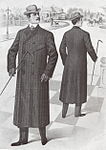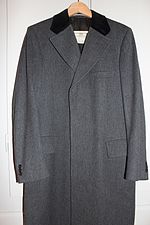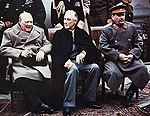Overcoat

Anovercoatis a type of longcoatintended to be worn as the outermost garment, which usually extends below the knee. Overcoats are most commonly used inwinterwhen warmth is more important.
They are sometimes confused with or referred to astopcoats,which are shorter and end at or above the knees. Topcoats and overcoats together are known asoutercoats.Unlike overcoats, topcoats are usually made from lighter weight cloth such asgabardineor covert, while overcoats are made from heavier cloth orfur.
History
[edit]In many countries, coats and gowns reaching below the knee have been worn for centuries, often forformaluses, establishing either social status or as part of a professional ormilitary uniform.In the 17th century, the overcoat became widely stylized and available to the different classes.
In theWestern world,the general profile of overcoats has remained largely unchanged for a long time. During theRegency,the fashion was to have very form-fitting clothes, with sidebodies, waist seams, and a flared skirt. Examples of this included thefrock overcoatandpaletot.
Chesterfield coat
[edit]Greatcoat
[edit]Agreatcoat(also watchcoat) is a large, woollen overcoat designed for warmth and protection against wind and weather, and features a collar that can be turned up and cuffs that can be turned down to protect the face and the hands, whilst theshort rain-capeat the shoulders protects from the wind and repels rain. In the 19th century, such a coat was part of a soldier'smilitary uniform,to be worn whilst on watch (guard duty), hence the termwatchcoat.[1]
The drape of the greatcoat reached to below the knee of the wearer, the short cape drapes to the elbow, and the capacious external pockets allow the wearer to carry dry food and other items; an example is thePetersham coat,named afterViscount Petersham.[2]In the fashion of theRegency era(1795–1837) a greatcoat might feature several short capes, usually designed, cut, andtailoredto the specifications of fit andaesthetic tasteof adandy.[3]Topcoat
[edit]Acovert coatorCrombiecoat is a gentleman's overcoat typically with notchedlapelswhich originated in the late 19th century as a "short topcoat" to be worn forhuntingandhorse riding.[4][5]
Since the 20th century, after the introduction of thesuitfor everyday use in town as opposed to thefrock coatand themorning dress,the covert coat is used as a shorter, moreinformaltopcoat option to the longer knee-lengthChesterfield coattraditionally associated withformal wear.Examples of overcoats
[edit]Some of the most common historical overcoats, in roughly chronological order.
| Image | Description |
|---|---|
| TheGreatcoat,a voluminous overcoat with multiple shoulder capes, prominently featured by European militaries, most notably the former Soviet Union. | |

|
TheRedingote(via French from Englishriding coat), a long fitted coat for men or women. |

|
TheFrock overcoat,a very formal daytime overcoat commonly worn with afrock coat,featuring a waist seam and heavy waist suppression. |

|
TheUlster coat,a working daytime overcoat initially with a cape top covering sleeves, but then without; it evolved to thepolo coatafter losing its cape. |

|
TheInverness coat,a formal evening or working day overcoat, with winged sleeves. |

|
ThePaletotcoat, a coat shaped with side-bodies, as a slightly less formal alternative to the frock overcoat. |

|
ThePaddock coat,with even less shaping. |

|
TheChesterfield coat,a long overcoat with very little waist suppression; being the equivalent of the "sack suit" for clothes, it came to be the most important overcoat of the next half-century. |

|
TheCovert coat,a classically brown/fawn, straight cut, single breasted country coat that became accepted for wear in the city with a suit as well as with tweed. It has a signature four lines of stitching at the cuffs and hem. It also had a fly front closure and 2 side pockets. The collar is sometimes made of velvet. |

|
TheBritish Warm,a taupe, slightly shaped, double-breasted, greatcoat, made of Melton, a heavy wool fabric, was first designed for British officers during the First World War, but was made famous by Churchill. The civilian variant usually drops the epaulettes. |
References
[edit]- ^Shindler, Colin (2018-11-29)."Thieves Who Became Heroes".The Jewish Chronicle.Retrieved2021-12-12.
- ^"The Free Dictionary".Retrieved16 May2013.
- ^French Gentleman’s Greatcoat,Regency World
- ^"covert coat".thefreedictionary.Retrieved2013-11-03.
- ^Schneider, Sven Raphael (January 24, 2012)."The Covert Coat".gentlemansgazette.Retrieved2013-11-03.
